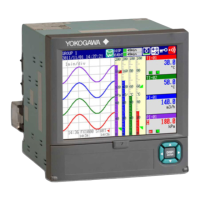1-4
IM 04L42B01-01E
1.2 Alarms
This function generates an alarm when the measured data meets a certain condition. Up
to four alarms can be set for each channel.
AlarmType
You can use the alarms shown below. The character inside the parentheses is the
symbol denoting each alarm.
For the alarm setting procedure, see section 3.7.
High Limit Alarm (H)
Alarm value
Alarm output ON Alarm output ON
Alarm output ON Alarm output ON
Alarm value
HysteresisMeasured value Measured value Hysteresis
Low Limit Alarm (L)
Alarm output ON Alarm output ON
Delay time Delay time
Alarm value
Alarm value
Measured value Measured value
Delay High Limit Alarm (T) Delay Low Limit Alarm (t)
High Limit on Rate-of-Change Alarm (R) Low Limit on Rate-of-Change Alarm (r)
Alarm value
Alarm value
Hysteresis Hysteresis
Difference in the measured values of two channels Difference in the measured values of two channels
Difference High Limit Alarm (h) Difference Low Limit Alarm (l)
Change in the
measured value
Change in the measured value
Measured value
Measured value
Time Time
Interval (t2-t1)
Interval (t2-t1)
Amount of change in
the setting
| |
T2
T1
t1 t2
T2
T1
t1 t2
T2-T1
Amount of change in
the setting
|
T2-T1
• AlarmHysteresis
You can set a width (hysteresis) to the value used to activate and release alarms.
• DelayHighLimitAlarmandDelayLowLimitAlarm
An alarm occurs when the measured value remains above or below the alarm value
for a specified time period (delay period).
• HighLimitonRate-of-ChangeAlarmandLowLimitonRate-of-Change
Alarm
The rate-of-change of the measured values is checked over a certain time (interval).
An alarm occurs if the rate-of-change of the measured value in the rising/falling
direction is greater than or equal to the specified value.
The alarm value of the rate-of-change alarm is set using an absolute value. The
interval is derived using the following equation and set using the number of samples.
Interval=thescaninterval×thenumberofsamples
For the setting procedure, see section 3.5.
• DifferenceUpperLimitAlarmandDifferenceLowerLimitAlarm
An alarm occurs when the difference in the measured values of two channels is
greater/less than or equal to the specified value. These alarms can be specified on
measurement channels set to difference computation.

